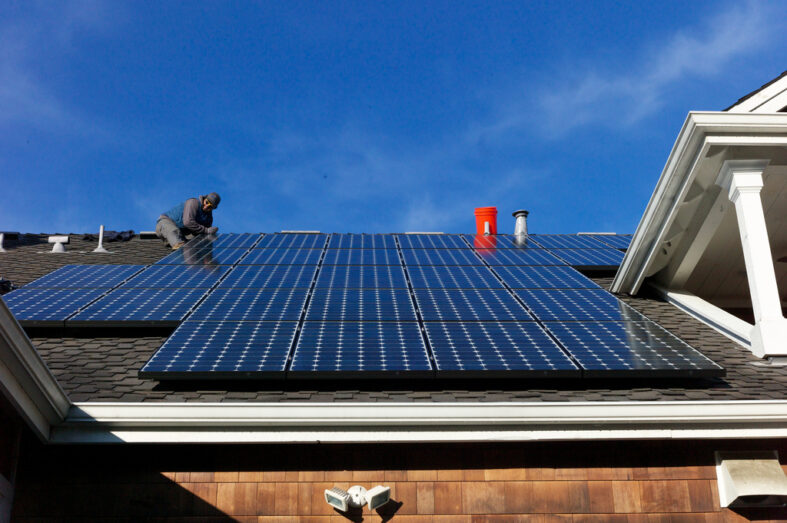Floridian's Can Do Their Own Solar: No Expertise Required Guide

Floridian’s can do their own solar: no expertise required guide is because any homeowner is allowed to do home improvements. Homeowners are only required to hire licensed installers and electricians when needed to meet the permitting & code requirements.
So lets say for arguments sake, you bought replacement parts for your car? You would seek out a qualified mechanic to do the work if you don’t have any expertise fixing your car. Wouldn’t you do the same thing if you bought solar panels?
Hire The Same People The Solar Company Does
The only difference between the two examples is most people know less about solar than they do about their car. It’s best to hire the expert installer/ electrician before you make any purchases of equipment. This is considered to be “doing it yourself” but what’s the difference if you hire the same people the solar company does, None!
The bottom line is the bottom line, you can save a small fortune and get the same equipment if not better. Companies add-on $10,000 to $15,000 over and above the cost of the solar equipment and installation.

The absolute bare minimum any solar company charges is $6000 over and above the cost of panels and installation. That’s just to get to breakeven and then they have to add-on $5000 profit based on a 7K solar system. $6000 is a low estimate because for many companies it can be as much as $10,000
Solar Company Proposal for a 7K System
| Add-Ons To Every Solar Proposal | Cost of Add-Ons |
| The Cost of Salesperson | $3000 |
| Sales Manager | $1500 |
| Proposal Builders and Permitting Department | $1000 |
| Overhead: Rent, Auto Insurance, Vehicles, and Utilities | $1000 |
| Cost of Leads and Marketing | $1000 |
| Points for Low Interest 20 Year Loan Terms (Frequently Hidden Cost) | $2500 |
| Solar Panels, Inverter, Installation | $17,000 |
| Solar Company Profit | $5000 |
| Total | $32,000 |
The solar company doesn’t pay any additional overhead costs, the buyer pays for them.
The solar company doesn’t pay out any of the costs until the finance company funds their account after financing is finalized.
Now you know” Why Is Home Solar So Expensive. Excess overhead costs is the driving force behind high home solar prices. Not only are the prices of home solar too high, but this business model is a hindrance to the growth of the home solar. But now there’s a better idea….
“Your Solar Advocate” Eliminates The Following Costs of Home Solar
| Add-Ons To Every Solar Proposal | Cost of Add-Ons |
| The Cost of Salesperson | |
| Sales Manager | |
| Proposal Builders and Permitting Department | $1000 |
| Overhead: Rent, Auto Insurance, Vehicles, and Utilities | |
| Cost of Leads and Marketing | |
| Points for Low Interest 20 Year Loan Terms (Frequently Hidden Cost) | |
| Solar Panels, Inverter, Installation | $17,000 |
| Solar Company Profit | |
| Total Cost with “Your Solar Advocate” Free Service | $19,250 |
Cut Out As Much Overhead Costs As Possible
The idea is to cut out as much overhead cost as possible because you want your home solar to be profitable. In 2020 and beyond home solar should be profitable because prices have gone down and consumer knowledge has increased.
There is no need to be paying ridiculous overhead costs the solar companies create. Homeowners deserve the profits from solar, not some random solar company. The only way you are going to get the best deal is to have an advocate who represents your interests only. Someone who knows the right contractors and wholesalers to guide you so you will get the best deal.
It does you no good to save money if the quality is not as good as a solar company. The beauty of working with “Your Solar Advocate” is you get to decide exactly the type of panels you want and what the various differences are? You get to decide how much you want to spend because you are dealing direct, cutting out the middleman?
US Solar Report
- How Does Solar Energy Create Jobs?
How Does Solar Energy Create Jobs? Emergence of the Solar Industry: How does solar energy create jobs? Homes and business’ must be retrofitted for solar systems. Implementation of mass solar power consumption will create millions of jobs n dozens of sectors. The solar industry encompasses various aspects related to harnessing energy from the sun. It The post How Does Solar Energy Create Jobs? appeared first on U.S. Solar Report.
- 3 Home Solar “Offset” Examples
3 Home Solar “Offset” Examples The 3 Home Solar Offset examples below are directly connected to the correct size of a Home Solar System. The power company bills you based on kilowatt-hours used during each month of the year. The term “Offset” is the amount of power produced from a home solar system that replaces The post 3 Home Solar “Offset” Examples appeared first on U.S. Solar Report.
- Federal Solar Tax Credit Guide 2024 Thru 2032
Federal Solar Tax Credit 2024 thru 2032 Step By Step Guide Federal Solar Tax Credit Guide 2021 Thru 2023 explains exactly how the Federal Solar Renewable Energy Tax Credit Works? More importantly, learn if it will work for you? Any tax credit earned when installing solar ( The Investment Tax Credit ) (ITC), allows you The post Federal Solar Tax Credit Guide 2024 Thru 2032 appeared first on U.S. Solar Report.
- How To Prepare for Going Solar
How To Prepare for Going Solar How To Prepare for Going Solar; The two most important things to do before installing home solar are to get a roof inspection and a possible air-conditioning system replacement. Replacing an older roof and the AC will save you money and lower your power consumption, sometimes quite dramatically. It’s The post How To Prepare for Going Solar appeared first on U.S. Solar Report.
- A Power Bill Is A Free Investment: Explained
A Power Bill Is A Free Investment: Explained A power bill is a free investment, because the money is being spent every month for a power bill with no return on investment. So why not invest the money into a home solar system, because it’s a risk free investment? The reason why people own a The post A Power Bill Is A Free Investment: Explained appeared first on U.S. Solar Report.
US Energy Information Administration Statistics & Analysis


